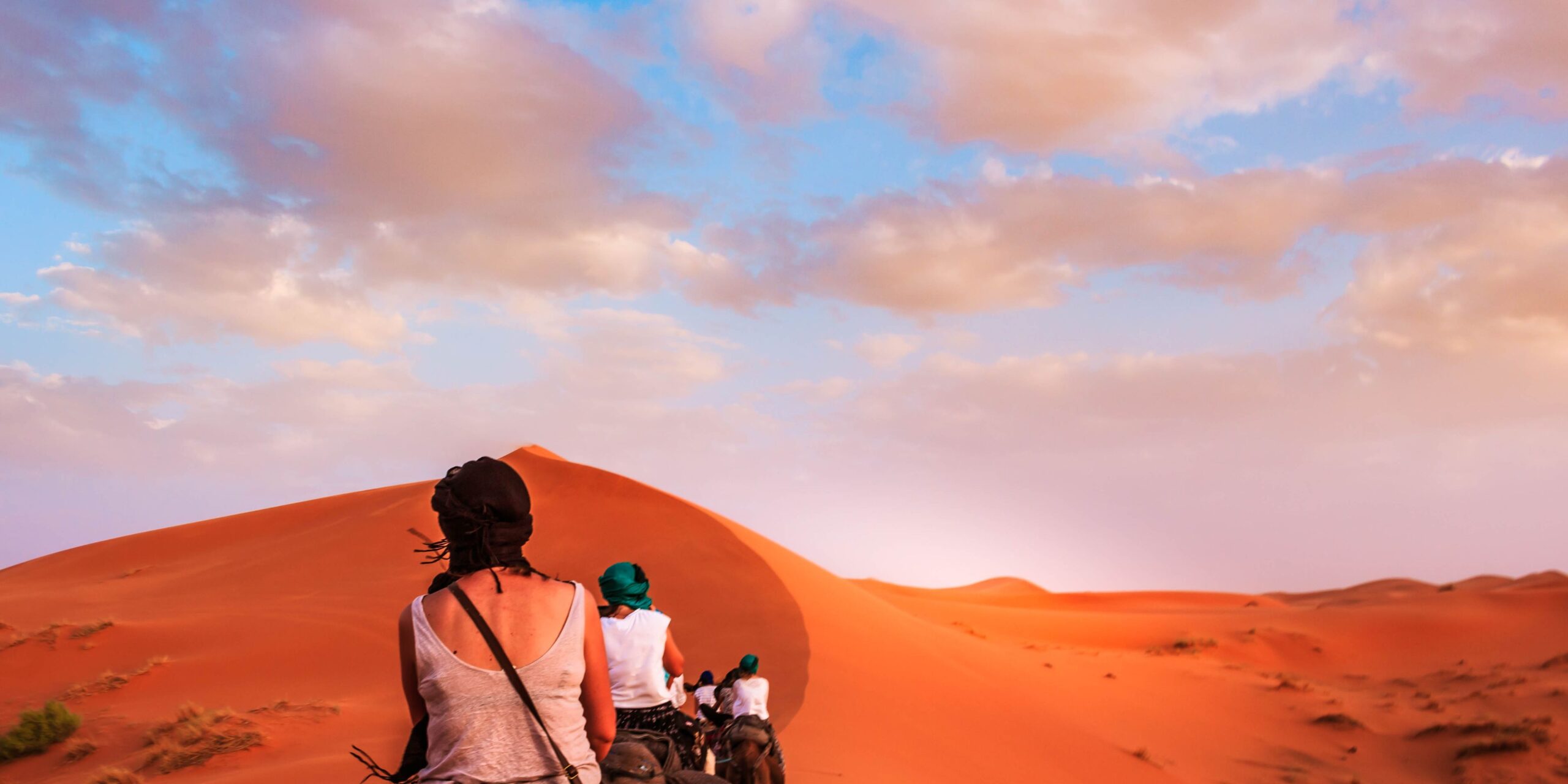Morocco offers a thrilling array of outdoor activities across its diverse landscapes. From rugged Atlas Mountains to sweeping Sahara deserts and Atlantic surf coasts, travelers of all budgets can find adrenaline-packed experiences. Key destinations include the High and Anti-Atlas for trekking, the Sahara (Erg Chebbi in Merzouga and Erg Chigaga near M’Hamid) for desert safaris, and coastal spots like Taghazout and Essaouira for surfing. Weather patterns vary: the best time for Atlas treks is spring through autumn, while the Sahara’s ideal season is spring/fall (avoiding midsummer heat). Summers in the desert can exceed 45°C, and winter nights can dip near freezing – pack accordingly (warm layers and a sleeping bag for desert nights).
Sunset over the Chegaga dunes in the Sahara Desert – ideal for camel treks and stargazing. The Sahara Desert offers unforgettable expeditions. Popular base camps like Merzouga (Erg Chebbi) and M’Hamid (Erg Chigaga) provide camel-trekking and 4×4 safari opportunities. The best time to visit the Sahara is in spring (March–May) or fall, when daytime temperatures are a comfortable 25–30°C. Summers are extreme (up to 45°C) and should be avoided, while winters bring cold nights (near-freezing). Camel tours usually include an overnight camp with Berber tents, tea and dinner, and often a night around a campfire under the stars. For example, many 3-day desert itineraries feature a 4×4 drive to camp, traditional dinner, local music, and a night gazing at the Milky Way.
Safety Tips: Always book through reputable operators or local guides; official advice warns to “restrict travel to officially designated areas, hire official guides… and ensure vehicles are properly equipped (4WD, water, etc.)”. Carry ample water, sun protection, and a first-aid kit. Avoid hiking or driving in the dunes after dark. For luxury desert safaris, consider glamping tents (with AC, gourmet meals) in Erg Chebbi or Erg Chigaga.
High Atlas & Mountain Trekking
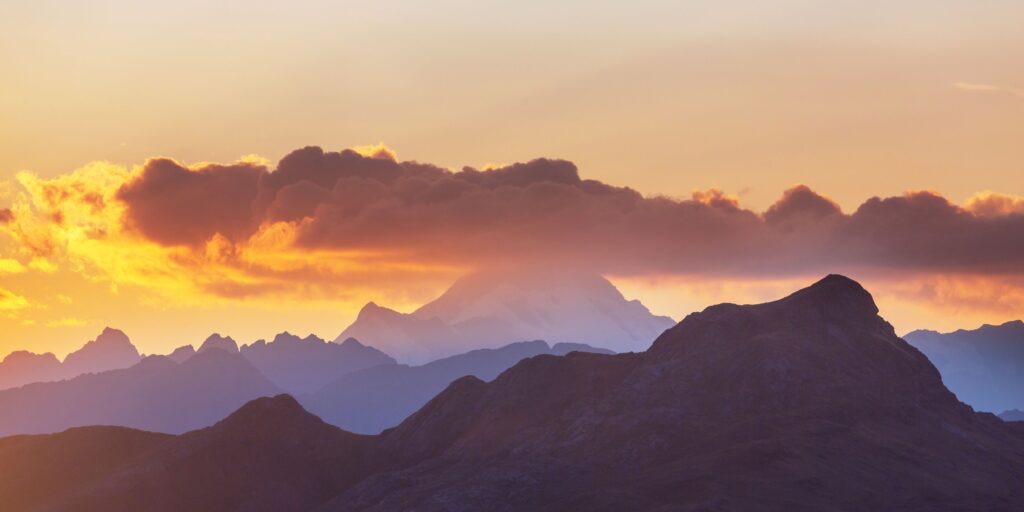
The Atlas Mountains are Morocco’s adventure backbone. Jebel Toubkal (4167m, North Africa’s highest peak) and neighboring ranges offer multi-day treks and shorter hikes. A guide notes the “best time to visit the Atlas Mountains is March–November”, as heavy winter snows can close mountain passes. Highlights include the Toubkal ascent (usually 2–3 days via Imlil), the Oukaïmeden circuit, and the M’Goun Massif loop. Local Berber guides often provide mule support and simple mountain huts (gîtes) for overnight stays.
- Routes: Popular trails include the Toubkal climb, the Imlil–Aroumd Rif Valley trek, and the M’Goun Gorge. Day-hikes around Imlil and Oukaimeden are good for acclimatizing. Signs are sparse, so using a guide is wise.
- Gear & Safety: Pack layers (cool mornings, warm afternoons), sturdy hiking boots, and a rain jacket. The weather can change rapidly. Use a certified local guide for difficult passages and always inform someone of your route. Acclimatize gradually to prevent altitude sickness.
- Accommodation: Options range from camping and budget refuges to mid-range gîtes and luxury eco-lodges with heated rooms and home-cooked dinners. Group tours (e.g. Intrepid Travel, Abercrombie & Kent) provide comfort camping or house stays. Travel insurance covering all trekking activities is highly recommended
Options range from camping and budget refuges to mid-range gîtes and luxury eco-lodges with heated rooms and home-cooked dinners. Group tours (e.g. Intrepid Travel, Abercrombie & Kent) provide comfort camping or house stays. Travel insurance covering all trekking activities is highly recommended
Popular trails include the Toubkal climb, the Imlil–Aroumd Rif Valley trek, and the M’Goun Gorge. Day-hikes around Imlil and Oukaimeden are good for acclimatizing. Signs are sparse, so using a guide is wise.
Pack layers (cool mornings, warm afternoons), sturdy hiking boots, and a rain jacket. The weather can change rapidly. Use a certified local guide for difficult passages and always inform someone of your route. Acclimatize gradually to prevent altitude sickness.
Surfing, Windsurfing & Watersports
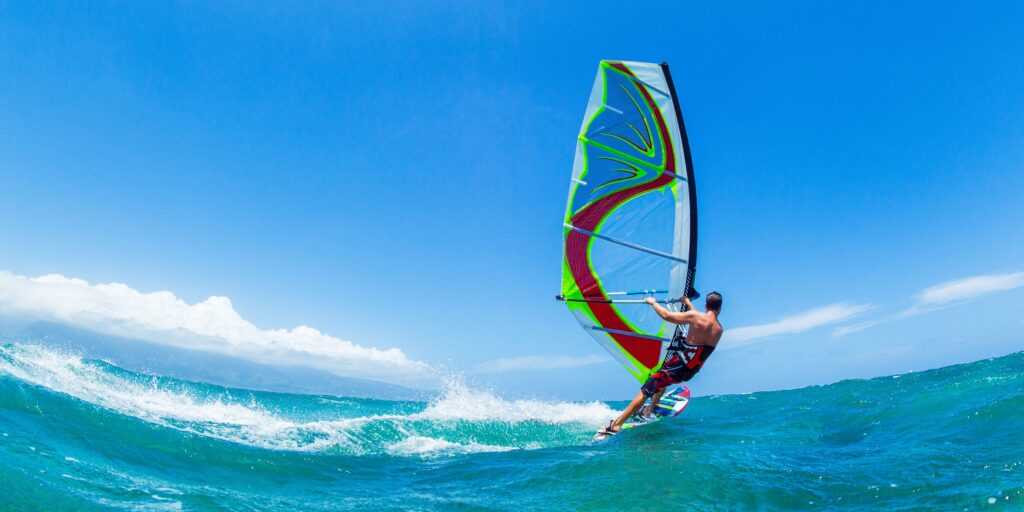
Morocco’s Atlantic coast is a surfer’s paradise. Taghazout (near Agadir) is Morocco’s surf capital, with consistent waves and peak swells from late autumn through spring. Among its famous breaks: Anchor Point and Killer Point (for experts), and Banana Beach (gentler, great for lessons).
Other watersports:
Windsurfing/Kitesurfing
Essaouira’s steady trade winds make it a world-famous kitesurfing destination (summer is prime season there). Dakhla in the south boasts a huge lagoon ideal for learning (winds are best in summer/autumn).
Kayaking & Rafting
Rivers like the Oum-er-Rbia and Ahansel in the High Atlas provide rafting (class II–IV in spring). The Oum-er-Rbia near Beni Mellal is popular for 2-day rafting trips with camping.
Diving & Snorkeling
The Mediterranean (e.g. near Al Hoceima) and Atlantic (e.g. Agadir, Legzira, Alboran Sea) both offer scuba options. Underwater reefs and shipwrecks can be explored with local dive centers.
Always check local weather (embed a wind/surf forecast widget if planning trips). Beginners should book lessons; most surf camps include gear and instruction (e.g. Tamraght Surf Camp, Essaouira windsurf clubs). Wetsuits are recommended outside summer. Respect marine safety rules: strong currents can run off Agadir and Essaouira.
Canyoning, Climbing & Mountain Biking
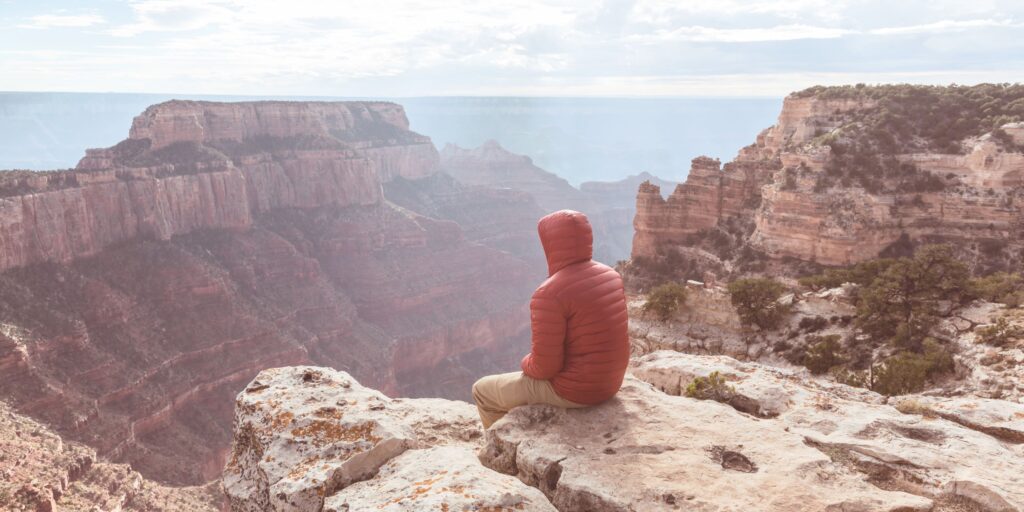
Morocco’s mountains and gorges offer extra thrills:
Canyoning & Rock Climbing
The Todra and Mgoun Gorges are world-class climbing venues (bolted sport routes up to 9a!). For canyoning, Paradise Valley (Agadir region) is known for natural water slides and pools – guided half-day trips (with swimsuits and helmets) are popular. The cedar forests above Azrou offer gentle stream hiking.
Via Ferrata
Via Ferrata: The Toubkal Park via ferrata (near Imlil) provides an aided climbing experience on iron steps and cables with stunning views. Suitable for adventurers with a head for heights.
Mountain Biking
Trails range from scenic to extreme. Notable rides: loop around the Skoura Oasis and red cliffs (easy), the Dades Valley tracks (moderate), and the Atlas passes (challenging). Day tours with bike rental (Shimano 29er or fat bikes) are available from places like Ouirgane and Tafraoute.
Planning, Seasons & Safety Tips
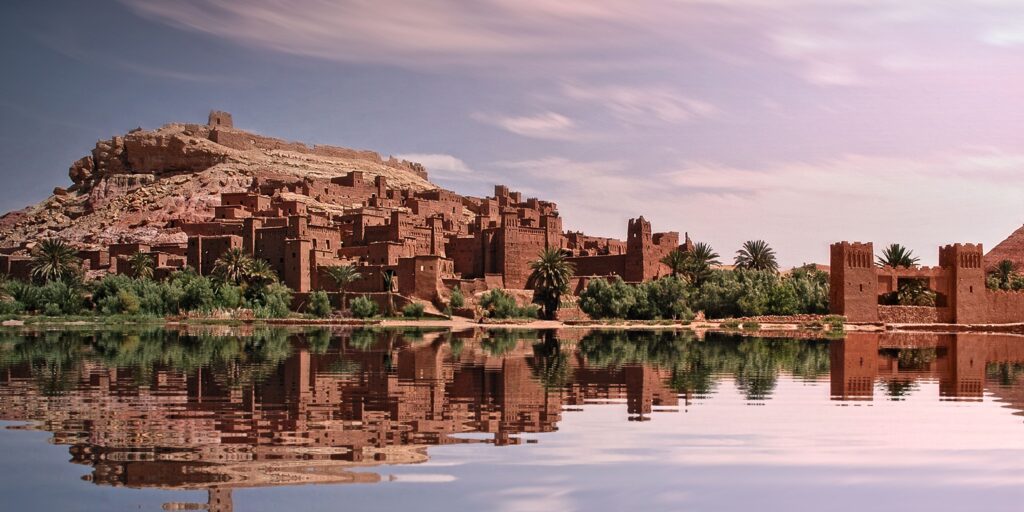
Seasonal Advice
Align activities with seasons: trek Atlas April–Nov, Sahara spring/fall, surf winter/spring, ski Atlas Jan–Mar. Festivals like the Gnaoua or Fez Sacred Music are tied to specific months (June); include these on your itinerary if interested.
Gear Up
Pack sunhat, high-SPF sunscreen, sunglasses, a refillable water bottle, and a power bank for devices. For desert trips, bring a headscarf (protects from sun and sand) and a headlamp for camps. For trekking, layered clothing (nights can be cold at altitude).
Health
Stay hydrated and use rehydration salts on long hikes. Carry a small first-aid kit and any personal medication. Springtime can mean high pollen – allergy meds may help. In mountains, ascend slowly to acclimatize.
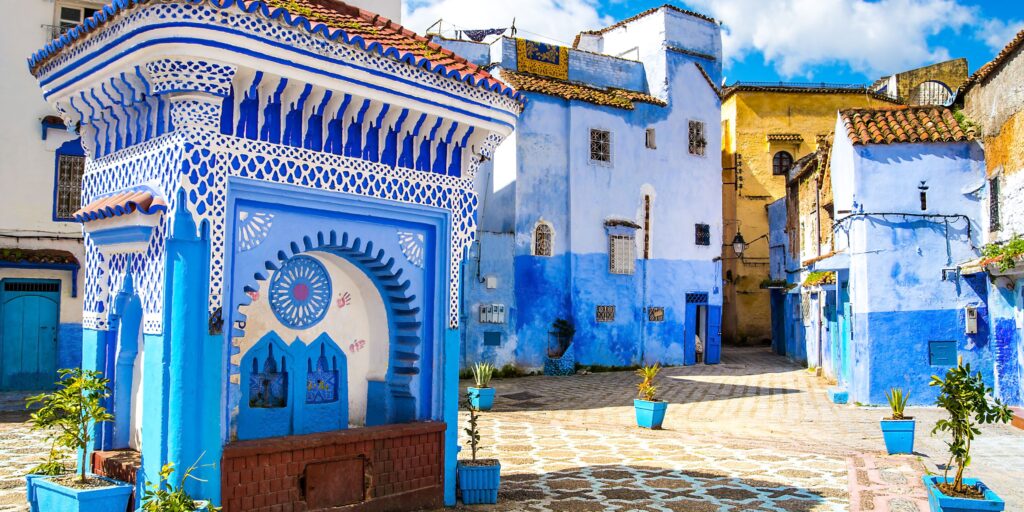
Stay Connected
Consider buying a local SIM (data works at desert camps and mountains) or renting a satellite phone for remote treks. Share your daily route with a friend or use a GPS tracking app.
Safety Warnings
Petty crime (pickpockets, bag snatches) can happen in medinas and on streets. Always guard your belongings. Never trek or drive alone in the desert or mountains at night. In remote areas, stick with guides. Moroccan travel advice emphasizes hiring official guides and drivers, and traveling only during daylight.
Emergency Prep
Carry ID, a copy of your passport, and emergency contacts. Pack an extra day of water and snacks in case plans change. Travel insurance covering rescue and medical evacuation is essential.
Budget vs Luxury Options
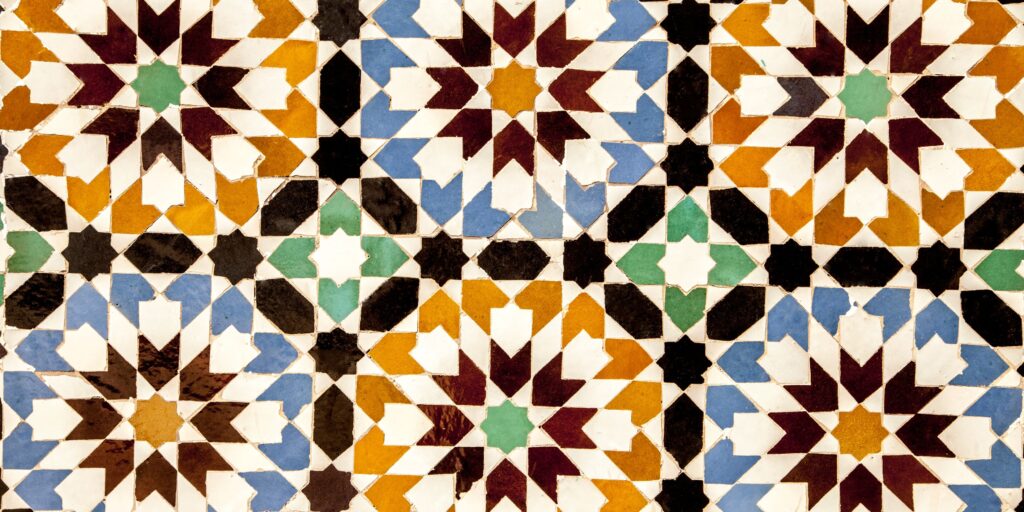
Morocco accommodates all budgets:
Luxury
High-end hotels/riads (pools, spas, $300+), private guides and 4WD vehicles, upscale desert camps with AC, and helicopter transfers between regions (for example, Marrakech-to-Essaouira heli-flights exist). Book through reputable operators and verify reviews.
Mid-Range
Riads (1700s mansions) turned boutique hotels ($60–150/night), small-group guided treks with 3–4 star lodging, private camels tours with basic tent lodging, mid-range surf camp (bed & breakfast).
Budget
Hostels and cheap guesthouses (30–50 USD/night), shared desert tours with camping, public transport, and street food (sandwiches, snacks from $1). Join group tours to split costs.
Tour Operators & Booking Links
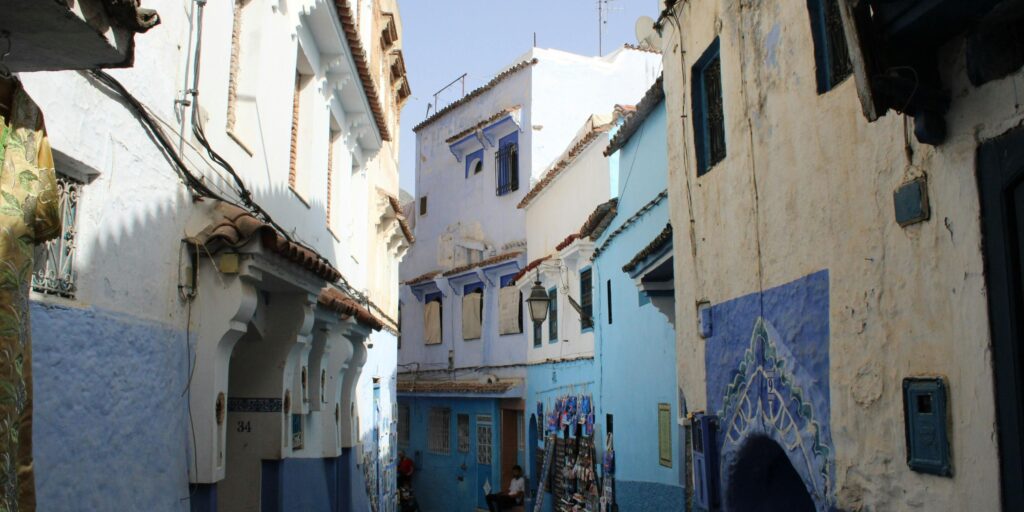
Use trusted tour companies and platforms:
Adventure Agencies
Intrepid Travel and G Adventures offer Morocco treks and surf trips for small groups. Local specialists like Atlas Hikes and Camel Trek Adventures run quality desert and Atlas tours.
Online Platforms
Websites like GetYourGuide and Viator list hundreds of experiences (camels rides, Atlas hikes, canyoning, windsurf lessons). Compare prices and read reviews.
Local Booking
Many riads and hotels can arrange day tours and equipment rentals at good rates. For example, ask your Marrakech riad to book a High Atlas horseback ride.
Transport Tickets
Book trains in advance via ONCF’s website. Domestic flights (e.g. to southern Morocco) can be booked on airlines’ sites. For buses, CTM and Supratours sell tickets at stations or online.
By following these tips, and combining recommendations from guides with local insights, travelers can safely enjoy Morocco’s adventurous side, whether backpacking on a shoestring or indulging in a luxury expedition.

